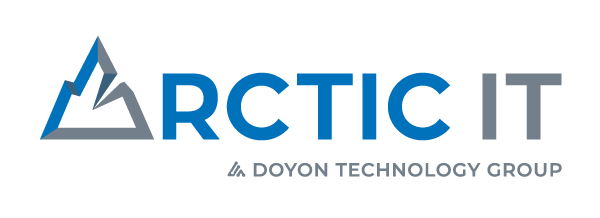When the COVID-19 pandemic hit in early 2020, the world wasn’t ready. Agility was afforded to some organizations who had already migrated their business operations technology to the cloud, while others were left scrambling to make remote work possible for staff.
Today, cloud technology is the ticket to business continuity and preparedness for the future. If you haven’t already, it’s time to make your move and accelerate to the modern workplace. We’ve put together a few discussion points below for your leadership team to consider.
First, cloud technology is modern workplace enablement
The cloud is a capability, not a destination. In short, “the cloud” refers to the process of accessing storage and computing power from data centers via the internet, which are not directly managed by the user. Data centers are located all over the world and house a vast network of cloud servers that operate as a single ecosystem. In order to enable the cloud for your organization, there are four main configurations of cloud deployment to consider: the public cloud, private cloud, hybrid cloud and multi-cloud.
The public cloud the most common cloud architecture utilized today. Top reasons for migrating to the public cloud, like Microsoft Azure or Amazon Web Services, include:
- Easy, inexpensive setup: Hardware, application, and bandwidth costs are covered by your cloud service provider (CapEx to OpEx)
- Scalable to your needs: Flexible resources that can grow with your business
- Low maintenance: The maintenance is covered by your cloud service provider
- Fault tolerance & geo-redundancy: A vast network of servers helps you defend against operational failure
There are three scenarios where you might consider migrating to the cloud. The first is Software as a Service (SaaS). SaaS allows staff or customers to easily access hosted business applications such as Office 365 and Dynamics 365 on any device in a secured commercial or government environment. The flexibility of SaaS apps allows for users and services to be added easily without the upfront software cost. Its subscription-based pricing model makes it easier to budget for as well.
Another scenario is Platform as a Service (PaaS). With PaaS, middleware and database/application infrastructure are migrated to the cloud so your team can focus on the delivery of applications and data. Azure and AWS are two platforms that provide highly scalable database management and business intelligence services via PaaS.
Lastly, there is Infrastructure as a Service (IaaS). IaaS supports the need to migrate legacy business applications to the cloud. For example, the virtual machines in Azure and AWS act as a replacement for physical hardware, allowing businesses to deploy custom servers and networking systems.
Second, business continuity is streamlined
Cloud technology uniquely accommodates the remote work needs of today – and into the future when it may be required again. A cloud services subscription like Microsoft 365 offers a variety of features from the latest business apps and Windows operating system paired with advanced device security for mobility. It gives your team the agility and flexibility to work on any device, anytime, anywhere while operating in a secured environment.
In response to the current business climate, Arctic IT client Mille Lacs Corporate Ventures and Drew McElrath – their Strategic Project Manager, stated, “We made the decision a while back to allow our team to work remotely. We are thankful Arctic IT transitioned us to online services as part of our recent projects with them.” Business continuity enabled with the cloud is a win-win for organizations and technology providers alike.
Third, collaboration is intuitive
Remote working is more effective and collaborative with a cloud-based app like Microsoft Teams. Teams gives users the ability to chat, meet, edit, organize, schedule and more – all within one app. The user interface is easy to use and requires little effort to get started.
Some of Teams’ best collaboration tools include:
- Virtual Meetings: Host and attend face-to-face meetings virtually – both scheduled and impromptu
- Screen Share: Share your screen or view another’s screen to review, collaborate, and troubleshoot together in real-time
- Chat: Chat throughout the day and during meetings – both individually and to whole teams
- Remote File Access: Make files available to the team for easy access wherever Teams can be accessed
- Outlook Calendar Integration: View your Outlook Calendar, attend meetings, and schedule new meetings within Teams as it syncs up with Outlook
Teams is also integrated with other cloud-based apps like the Microsoft 365 office app suite (PowerPoint, Excel, Word, etc.), as well as Dynamics 365 for easy access to application data from your ERP or CRM. Advancements with this cloud collaboration tool allow you to customize Teams for your unique business operations.
Fourth, security is embedded
Cloud technologies are more secure and built with security and compliance in mind. From the ground up, services like aforementioned Microsoft 365 are ahead of the game. Microsoft 365’s built-in security capabilities include:
- Identity and access management – Protect your users’ identities and control access to valuable resources with multi-factor authentication, privileged identity management and leaked credential reporting/monitoring
- Information protection – Ensure your documents and emails are seen only by authorized people coupled with IT visibility over ongoing risk assessment and analytics
- Threat protection – Protect your organization against advanced threats like malware, detect abnormal behavior based on the latest shared intelligence, and recover quickly when attacked
- Security management – Gain visibility and control over your security tools with a platform-driven dashboard and security reporting
Where legacy technology is constantly playing catch-up to the latest threat landscape, cloud technology has the ability to identify threats and immediately push security updates with agility.
Fifth, modern workplace is delivered
The modern workplace can be defined as the evolution of an organization to adopt new technology and operational processes that meet the ever-changing demands of business and security. By today’s standards, most businesses need flexibility so staff can be productive anywhere, any time.
Achieving office productivity has never been easier with cloud technology like Microsoft 365, Dynamics 365, and Azure. You and your team can:
- Collaborate on business app documents simultaneously
- Share calendars with advanced email functionality through Outlook and Exchange
- Chat, meet, and work together in one window with Microsoft Teams
- Build low code/no code apps and workflows to connect distributed processes
- Report and forecast with real-time data analytics
- Engage anywhere, anytime on any device
Ultimately, you will save time, money, and resources with cloud technology and security at scale. The key to the modern workplace is in the cloud, are you ready?
For questions about the cloud or to get started with a cloud migration project, please reach out to [email protected] today.

By Phillip Jackson, CIO at Arctic IT

